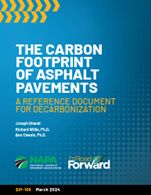
Highways agencies around the world are under pressure to reduce the carbon emissions associated with road construction and maintenance operations. But one of the most challenging aspects is working out the best way to do that, with a multitude of parameters to consider – as well as the multitude of new ‘lower carbon’ technologies which are appearing on the market.
In the US, agencies have the additional motivation of increased funding to draw on if they choose solutions with lower carbon footprints. The National Asphalt Pavement Association (NAPA) has come to their aid with a comprehensive guide on ways to do that. It would make useful reading for any highways agency looking to create a carbon reduction roadmap.
In the UK, local authority highways departments are working towards local goals which map out their council’s pathway to net zero, many of them very ambitious. The Mineral Products Association (MPA) has produced a set of benchmark environmental product declarations (EPDs) so that decision makers can compare products from different suppliers and get a clearer picture of how the technology they choose could cut carbon emissions.
Meanwhile, Swedish airport operator Swedavia is trialling asphalt containing both polymer modified bitumen (PMB) and a biogenic binder from Nynas in a bid to produce pavements that have a lower carbon footprint when laid, while requiring lower maintenance in operation.
NAPA
NAPA, the National Asphalt Pavement Association, is the trade association for asphalt producers and contractors in the US. It has published a guide on cutting carbon emissions associated with asphalt roads. The document helps to identify where the industry should be concentrating its efforts and what strategies can give the biggest carbon reduction impact.
‘The Carbon Footprint of Asphalt Pavements: A Reference Document for Decarbonization (SIP 109)’ is a 62-page guide which breaks down the sources of carbon emissions throughout the lifecycle of a road and sets out opportunities for asphalt suppliers, contractors and highways agencies to reduce carbon emissions.
Reducing carbon emissions is not only necessary to reduce the rate of global warming; it is an opportunity for the industry and agencies to leverage more federal funding, says NAPA. For instance, 13 states are signed up to the Federal-State Buy Clean Partnership, launched in March 2023, which sees states agreeing to prioritise the procurement of low-carbon infrastructure materials for state-funded projects.
A further incentive came in March 2024 when the Federal Highways Administration (FHWA) launched the Low Carbon Transportation Materials Program. The programme will make $2 billion available to state departments of transport and other agencies to buy lower carbon materials, including steel, concrete and asphalt.
Breaking down the proportion of carbon emissions associated with a typical asphalt mix from cradle to gate, the guide illustrates that 57% of emissions are due to materials, 38% due to plant and 5% to transportation. Looking at the asphalt mix itself, the binder accounts for 94% of carbon emissions, whilst aggregates are responsible for 6% even though they account for 95% of the mix by mass.
Among the carbon-reducing measures explained in the guide, NAPA identifies the use of higher proportions of recycled asphalt planings (RAP) in asphalt mixes as being perhaps the biggest and easiest win. The average proportion of RAP deployed in asphalt mixes in the US is 20% which gives a reduction in cradle-to-gate emissions of 12%; by boosting that to 50%, carbon savings rise to 29%.
Other industry-driven opportunities to cut carbon include the consideration of biobased materials in the binder, use of warm-mix asphalt or cold central plant recycling technologies and switching to lower carbon fuels at mixing plants. Laying roads with higher densities and improved smoothness will reduce carbon emissions during a road’s lifetime by extending the life of the asphalt, says the guide.
For highways agencies, the NAPA guide points out that for roads with low volumes of traffic, it makes sense to focus on lower carbon materials as a means of reducing emissions. For highly trafficked roads, that need frequent maintenance and resurfacing, efforts should be focussed on reducing carbon by choosing mixes that deliver better performance and increased longevity.
Agencies should consider the Perpetual Pavement design approach, which the guide says offers the biggest opportunity to reduce carbon emissions over the entire lifecycle. By ensuring that every layer of a pavement is optimised so that it does not fail structurally, Perpetual Pavement design can lead to a 20% reduction in lifetime carbon emissions.
Specifications should be adapted to allow contractors the flexibility to use lower carbon materials and practices, says the guide, such as adoption of balanced mix design (BMD). This approach deploys performance testing to optimise an asphalt mix’s performance in terms of rutting and cracking and could, for instance, allow higher proportions of RAP to be used and hence more carbon to be saved.
Among the areas identified by NAPA as requiring more research in the bid to cut carbon is the potential impact of using biobased materials, the impact of work zone congestion on carbon emissions, and how pavement smoothness and texture effects vehicle fuel consumption.
MPA
Meanwhile, the UK industry has published reference EPDs for most common asphalt mixes. The UK’s MPA has published EPDs for four generic asphalt mixes. The aim of these reference EPDs is to allow highway authorities to take decisions at the scoping stage of projects and to make comparisons between different products based on their environmental performance.
EPDs are a way of expressing global warming potential, expressed in carbon dioxide equivalent emissions (CO₂e). Also known as the carbon footprint, the EPDs produced by the MPA cover cradle-to-gate emissions associated with the mixes, stages A1 to A3 in lifecycle analysis terms.
The four types of asphalt mix represent the most commonly used product types for the UK: asphalt concrete for base and binder layers; hot rolled asphalt; stone mastic asphalt (SMA) type surface course; and thin surface course, asphalt concrete (AC) type with polymer modified bitumen (PMB).
MPA has used a combination of data from MPA members and generic information to calculate the EPD figures, using the OneClick Life Cycle Assessment (LCA) tool, in accordance with BS EN 15804:2012+A2:2019 which sets out rules for construction EPDs. Each of the MPA’s reference EPD explains how many manufacturers contributed to the data, and how much of the UK’s production their output covers.
Brian Kent, Chairman of MPA Asphalt, commented: “MPA members are increasingly asked for published and verified EPDs relating to the supply of asphalts. But, while we have been able to generate carbon calculations and verified EPDs, the burden of doing so for numerous individual product types from specific plants on a site-specific basis incurs significant additional expenditure. The introduction and adoption of these industry EPDs will mean costs won’t be passed on, benefiting all stakeholders.”
While MPA members and other asphalt producers will be able to use these generic EPDs, they will also act as a benchmark for companies that want to show they can do better. MPA members will soon be able to log onto an online tool where they can calculate their own EPDs and compare these against the reference figures.
“With more user data we will also be able to further refine our calculation assumptions and embedded datasets to be even more representative,” said MPA’s director of asphalt, Malcolm Simms. “Plus, members can consistently assess and compare their own progress at site or project level using their primary data”
Skanska has used a PMB containing biogenic binder material for the resurfacing of a taxiway at Stockholm Arlanda Airport in Sweden. Working for state-owned airport operator Swedavia, Skanska replaced around 20,000m of wearing course between the runways and the terminal building in May this year. Skanska paved the taxiway in two sections, one containing an asphalt mix with Nypol RE 73 and a reference section made with a conventional binder, Nypol 76-28.
Nypol RE contains a biogenic component which replaces part of the oil-derived bitumen binder. The biogenic component, because it is derived from plants or trees that sequester carbon as they grow, lowers the binder’s carbon footprint. Nynas has engineered Nypol RE so that 1tonne of Nypol RE has the same carbon footprint as 1tonne of unmodified standard paving grade bitumen, with the added performance benefits of a PMB.
The asphalt for the taxiway must be able to withstand various substances such as potassium formate, a de-icing chemical. Skanksa carried out tests to compare the performance of wearing course asphalt made using Nypol RE against the standard PMB. “Our tests show that Nypol RE is at least as good as the reference binder," said Skanska’s bitumen and asphalt specialist Kenneth Olsson.
Swedavia was willing to deploy the lower carbon solution at Arlanda Airport because it has set itself the goal of next-zero greenhouse gas emissions by 2040. Longevity is important too, said Sandra Säfström, environmental specialist at Swedavia
"We need to test alternatives with reduced climate impact in order to achieve our environmental ambitions in the long run while maintaining today's high standards of functionality and aviation safety," she said. “Our vision for 2030 includes a zero-waste goal and a focus on circular business models, which Nypol RE can contribute to through the expected increased maintenance intervals.”










